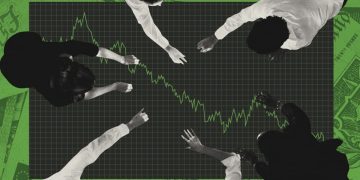The Investor’s Paradox: Market Optimism in a Slowing World
1. Introduction: Confidence in a Constrained Environment
By 2025, global investors face a paradox:
Markets appear resilient, equity indices hover near multi-year highs, and liquidity remains abundant — yet macroeconomic indicators signal slower growth, rising geopolitical tension, and persistent inflationary pressures.
Peter C. Oppenheimer, former Chief Global Equity Strategist at Goldman Sachs, often emphasizes the duality of financial markets:
they are simultaneously reflections of fundamentals and projections of sentiment.
Investor optimism can persist even as real-world conditions deteriorate, creating periods of apparent stability that conceal hidden fragility.
This essay explores the forces shaping investor behavior, asset valuation, and market dynamics in 2025, drawing on Oppenheimer’s philosophy: that understanding the psychology of markets is as critical as analyzing balance sheets.
2. Global Economic Slowdown: A Background
After years of post-pandemic recovery, the global economy is losing momentum:
- IMF forecasts a GDP growth slowdown from 3.3% in 2024 to 3.2% in 2025, and further to 3.1% in 2026.
- OECD predicts even lower global growth at 2.9%, citing trade uncertainty, rising tariffs, and geopolitical risks.
- Inflation remains above central bank targets in the U.S., Europe, and parts of Asia, despite tight monetary policies.
Yet despite these headwinds, financial markets have maintained buoyancy, sustained by central bank liquidity, corporate earnings resilience, and persistent retail investor participation.
Oppenheimer calls this “optimism divorced from macro reality”, a hallmark of markets in transitional periods.
He stresses that investors often extrapolate short-term trends while underestimating structural risks — a behavior he terms the paradox of confidence.
3. Equity Markets: Valuation and the Risk-Return Tradeoff
Equity markets in 2025 demonstrate several intriguing patterns:
• Compressed yields
Low global interest rates — despite intermittent hikes — have led to historically low bond yields.
Investors seeking returns gravitate toward equities, sustaining high price-to-earnings ratios in sectors such as technology, renewable energy, and healthcare.
• Sectoral divergence
While tech stocks remain elevated due to AI, cloud computing, and fintech adoption, traditional sectors (manufacturing, commodity-based industries) experience muted performance, reflecting structural shifts in productivity and global supply chains.
• Investor sentiment
Oppenheimer emphasizes that market optimism often becomes self-reinforcing.
Retail investors, influenced by social media, ESG narratives, and thematic investment products, perpetuate momentum, even when macro fundamentals signal caution.
The paradox is clear: investors are willing to pay for future potential rather than present value, a behavior that can sustain bubbles until sentiment abruptly shifts.
4. Bond Markets and Yield Dynamics
While equity markets attract attention, bond markets in 2025 illustrate subtle signals of stress:
- Sovereign yields in Europe and the U.S. remain low due to central bank purchases, but credit spreads in emerging markets are widening.
- High-yield corporate debt is increasingly concentrated in firms with aggressive leverage, reflecting risk tolerance fueled by abundant liquidity.
- Inflation-linked instruments indicate persistent price pressures, particularly in energy and commodities sectors.
Oppenheimer highlights that yield curves are now as much a measure of sentiment as of fundamentals.
Investors interpret central bank communications and geopolitical news more than actual economic data, leading to volatility disconnected from real GDP trends.
5. The Role of Central Banks
Central banks remain central actors in the investor paradox:
- The Federal Reserve and European Central Bank oscillate between tightening and pausing policies, seeking to balance inflation and growth.
- In Asia, China and India pursue selective monetary easing to support domestic markets while managing currency stability.
- Central bank interventions — bond purchases, repo operations, and forward guidance — reinforce investor belief that policymakers will prevent sharp market declines.
Oppenheimer argues that this has distorted risk perception:
Investors may underprice systemic risks because they assume liquidity backstops are reliable, creating moral hazard in both equity and debt markets.

6. Behavioral Insights: The Psychology of Optimism
Investor behavior in 2025 reflects long-studied psychological biases:
- Extrapolation Bias: Investors assume recent gains will continue, even amid economic deceleration.
- Confirmation Bias: Positive news (AI breakthroughs, tech earnings) outweighs negative macro signals.
- Herding: Momentum trading and thematic investing amplify trends, often independent of valuation.
Oppenheimer emphasizes that understanding sentiment dynamics is critical to navigating modern markets:
Even sophisticated institutional investors are subject to emotional cycles, which can exacerbate price swings during periods of uncertainty.
7. Emerging Market Dynamics and Cross-Border Capital
Capital flows into emerging markets (EM) illustrate another paradox:
- EM equities and bonds attract foreign investors seeking yield in a low-interest global environment.
- Simultaneously, geopolitical risks — U.S.-China tensions, regional conflicts, and currency volatility — threaten sudden capital reversals.
Oppenheimer notes that this tension creates both opportunity and fragility:
Markets appear liquid and growth-oriented, yet structural risks remain underpriced, potentially amplifying corrections if sentiment reverses.
8. ESG Investing: Optimism with Constraints
Environmental, Social, and Governance (ESG) investing has matured but introduces complexity:
- Capital flows favor ESG-compliant companies, often at the expense of non-compliant but financially stable firms.
- Investor optimism around ESG narratives may inflate valuations, disconnecting market performance from operational realities.
- Oppenheimer warns that narrative-driven investing, while socially conscious, can increase susceptibility to shocks when public sentiment shifts.
9. Risk Management in a Complex Market
Oppenheimer emphasizes the importance of discipline in risk assessment:
- Diversification: Geographical and sectoral diversification remains essential, particularly given asymmetric global growth.
- Liquidity monitoring: Markets may appear stable, but liquidity constraints in stress scenarios can produce outsized losses.
- Scenario planning: Investors must model outcomes under multiple stress scenarios, including inflation spikes, interest rate shocks, and geopolitical events.
- Sentiment analysis: Tracking behavioral signals can anticipate market inflection points before fundamentals shift.
These principles underscore a central tenet:
markets are complex adaptive systems, and investor psychology is an inseparable component of risk dynamics.
10. The Paradox of Confidence
The paradox that Oppenheimer identifies is stark:
- Markets are confident, yet fundamentals are weakening.
- Liquidity is abundant, yet structural risks are rising.
- Optimism persists, yet uncertainty is pervasive.
This creates conditions where prices can be disconnected from reality for extended periods, until some trigger — a geopolitical shock, a corporate default, or policy misstep — forces realignment.
11. Preparing for 2026: Lessons for Investors
Oppenheimer advises that investors approaching 2026 should:
- Balance optimism with realism: Recognize market resilience but prepare for volatility.
- Focus on fundamentals: Earnings quality, balance sheet strength, and cash flow matter more than thematic hype.
- Monitor policy signals: Central bank guidance, fiscal policy, and regulatory changes influence market psychology.
- Incorporate behavioral intelligence: Understanding how investors react to news can provide early warning of inflection points.
In essence, successful investing is no longer about predicting numbers alone; it is about navigating sentiment and structural dynamics simultaneously.
12. Conclusion: Optimism in a Slowing World
Peter Oppenheimer’s 2025 perspective offers a profound insight:
Markets are simultaneously rational and emotional, fundamental and speculative.
The global slowdown, geopolitical friction, and rising interest rate uncertainty have created conditions where investor optimism persists despite structural risks.
This paradox demands discipline, awareness, and behavioral insight from those navigating global capital markets.
For investors, policymakers, and institutions alike, the lesson is clear: confidence is fragile, liquidity is not resilience, and optimism is not a guarantee of safety.
The investor’s paradox is not a theoretical abstraction; it is the defining feature of 2025’s global financial environment.



































